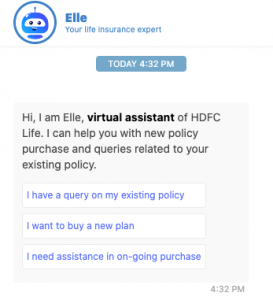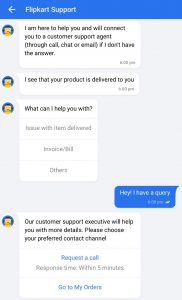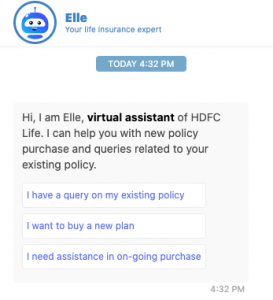5 Incredible Omnichannel Customer Service Strategies to Win Customers
Blog: MattsenKumar Blog
All organizations building omnichannel expertise have recognized that different customers will use other channels to browse, engage and seek support. This acknowledgment allows businesses to expand to numerous media, including Call, Chat, Email & SMS, and then integrate them into a central repository. Through this repository, companies can identify queries raised by customers instantly irrespective of the channel it was introduced through.
Omnichannel customer service is no more a privilege; it is a sheer necessity to delight and retain customers. A study highlights “businesses that adopt omnichannel strategies achieve 91% greater year-over-year customer retention rates compared to a business that doesn’t”. Initially, marketers relied on omnichannel expertise to acquire customers, soon operation leaders incorporated it to delight customers, and now CX representatives want to leverage omnichannel to retain customers.
Current State of Customer Service
The current state of customer service is chaos. Like a famous fictional character once said, “chaos is a ladder”; this is an opportunity for all organizations to contemplate going omnichannel. With all channels coming together to help support agents view all queries raised by users instantly, we are looking at:
- Quicker resolution
- Incomparable customer experience
- Increasing return rate
- Word of mouth marketing
- Brand development
- Referral sales
- Repeat purchases
Some of the challenges omnichannel customer service methodology can solve are:
- 48% of customer service professionals say that creating a good customer experience is a priority.
- Customers want to access self-help and get in touch with agents too. It depends upon the level of the issue being faced by the customer.
- Millennials prefer to chat and email, whereas baby boomers are adamant about calling for customer service.
- 54% of customers agree that their customer service expectations have increased over a year. Source
All the challenges, as mentioned earlier, be it creating a quality customer experience or catering to both millennials & baby boomers with equal effectiveness, can be solved by having an omnichannel customer service strategy. Omnichannel is revolutionary when viewed as a way of improving customer service; it reduces the time taken to cater support, enhances agents’ efficiency, and allows customers to access the same support across platforms & channels.
How can Omnichannel help Improve Customer Service?
Customer experience as a whole is a collection of several events where the customer had fun interacting with your business. A seamless, empowering, or delighting process adds to the overall customer experience and makes customers come back again and again. A quality CX is equivalent to eating sugary products leading to a dopamine-releasing, which makes us crave more.
An effective omnichannel customer service strategy can help businesses become customer-friendly or preferred shopping partners. Some of the top benefits of having an omnichannel strategy are:
Reduced Resolution Time: When agents can view all queries raised by a customer irrespective of the platform on a centralized system, they will understand the prevailing challenge without the customer repeating it. Such nuanced events make customers feel empowered and help the agent in offering faster resolutions.
Customer Feels Valued: Customers understand that organizations that have omnichannel expertise are focusing on improving customer experience. As a result, users crawl back to such organizations time and again. They are sure that their complaints will be heard and catered to at the earliest at such organizations.
Improves Reporting & Analytics: One centralized system showcasing all challenges faced by customers makes it easier to identify channels or touchpoints leading to maximum issues. In addition, such a centralized view will allow organizations to prioritize problem-solving by deploying more resources or rendering the particular channel obsolete.
Trending Omnichannel Customer Service Strategy
1. Offering Support at Every Touchpoint
Implementing an omnichannel support strategy allows businesses to solve customer challenges way before they occur. Customers reach out to support agents either for help regarding a product they are trying to purchase or looking for information on already purchase products and mainly for post-sale support.
For Fintech players, omnichannel expertise will work better if it ensures that all customers are assisted by purchasing insurance, stock, or mutual funds. For example, when buying insurance, customers ask multiple questions. They are scared of ticking the wrong option, a support agent, either on-call or a live chat can help the customer have a smooth experience.
Similarly, for e-commerce players, omnichannel expertise can help customers install and operate an imported machine readily because a support agent is taking them through the entire process, which started with customers showing buying interest.
Here’s how to do it:
Help customers find relevant products: Almost all banks now have a virtual assistant trying to help customers find the right product on the main website.
One of India’s leading Insurance players, HDFC Life, has a virtual assistant named “Elle.” She pops up every time you visit the site, irrespective of the device. She is designed to help customers navigate through the area with great ease. One message to her, and you are likely to find the desired result within seconds.

Assist customers make informed decisions: Once you go ahead and select a product and request a callback, a human agent is assigned to you. HDFC Life understands insurance is a sensitive matter, and customers are often to proceed on their own. Therefore, the human agent keeps up with the customer and tries to solve all queries.
Once the customer decides to make a purchase, the human agent assists in completing the entire purchase process. They are responsible for explaining every stage, which stirs confidence in customers and helps them have a good customer experience.
Onboarding support: Once the customer selects a policy and pays the initial premium, their order is confirmed, and now they are moved to the onboarding stage. Here customers are required to login into the account using their email id and password and upload all relevant documents to verify age, address, income, and health status. Only after all the mentioned documents are uploaded and confirmed that the purchased policy comes into effectiveness.
A human agent assists through the entire onboarding process and ensures that all correct documents are uploaded.
Post-sale Support: Well, once all required documents are uploaded, verified, and policy becomes effective, the buying stage is over. Now customers can log in to their accounts and view all information like “sum assured, monthly premium, accidental benefits,” or they can request a callback.
Once they request a call, a human agent will contact them and answer questions about the purchased policy. This post-sale support helps customers feel relieved. In addition, quality experience influences users to recommend a platform to more people.
2. Build a Team of Omnichannel Leaders
Organizations need to stop eyeing omnichannel customer service as an experiment and make it irreparable. Instead, it’s about time businesses start having a team, a leader, and a set of executives to look after the implementation, improvement, and management of omnichannel expertise.
Why having an Omnichannel Ambassador Makes Sense?
Ensures Seamless Integration: Just like compliance failure invites hefty fines, missing out on channel integration can penalize businesses through customer churn and dipping NPS. With an ambassador responsible solely for overseeing omnichannel customer service strategy, companies can achieve zero downtime and continue to cater to all customers effectively.
Make Centralized System Mainstream: The key to effectively implementing an omnichannel customer service strategy lies in having a centralized system. A centralized system, which stores all tickets and integrates them based on “customer number or order id” will make data accessibility easier.
It is easier to monitor, analyze and implement changes on a centralized system. In addition, updating tickets for phone-related queries will reflect across all channels and allow other teams to view the status of the question.
For example, A customer who initially logged the complaint through email can receive a final resolution over the phone. The call support agent will mark the query resolved, and it will start reflecting for the email team.
Tighten the Grip: Since omnichannel is a new technology, existing agents who are comfortable with their processes are likely to be uncomfortable with the recent developments. An ambassador will oversee that the email support team is supporting the call answering team and vice versa.
Often agents will not like going beyond their domain areas and support a customer, but then it will kill the purpose of having an omnichannel customer service strategy. However, with ambassadors setting timelines on all queries and assigning roles, it will get easier for customers to seek quality support across all channels.
Reporting & Analysis: Well, omnichannel surely automates customer service and removes boundaries, which earlier limited agents. Now that there are no boundaries and the scope of customer service is bigger, so are the challenges. One needs an expert in the field to consider all factors when preparing a report and to submit the final analysis. A seasoned professional with real-time experience in managing contact center operations will be a good fit.
3. Optimize all Channels for Mobile Devices
The app-based economy is booming, from music to cab and even for payment; we now have an app for everything in life. For example, one can rely on mobile applications to order food, a masseur, and even a cleaner.
With mobile applications becoming mainstream, customers are expecting to be offered quality support through these devices. However, providing quality support through mobile devices and still ensuring the omnichannel experience is challenging but not entirely impossible.
Here’s how to build it:
As we know, 65% of all e-commerce support requests generate on mobile devices; it is indispensable to build a system that offers resolution on mobile devices too.

Allow Customers to “Request a Call”: Leading e-commerce platform Flipkart allows customers to request a call through their mobile application. The app even allows customers to feed a time best suited for a call. Such customized and personalized options stop customers from shopping from elsewhere.
Embed Live Chat on Mobile App: Leading cab aggregator Uber and food aggregator Swiggy have embedded live chat on their mobile devices. This allows customers to seek support and update about their orders in real-time. Any issue can be resolved in real-time, including order update, cancellation, refund, or raising a complaint.
Customers can seek support through multiple channels, including call, chat, and email, without leaving their mobile; this is a unique example of an omnichannel customer service strategy.
Have an Issue? Tweet it: Yes! Mobile applications now allow users to share their feedback after a good experience on social media. “Had a good experience? Share it on Facebook” is perhaps one of the most repeated phrases. Organizations can do the same with problem-solving since social media takes an average of 40 mins to resolve a query, which is significantly less compared to the average time for resolution on email and over the phone.
Query Updates Through Push Notification: Fintech, E-commerce, Food & Cab aggregators have been using push notifications to inform users about their upcoming orders and out for delivery updates. Using push notification to provide customers update about their query raised across the platform will be a good use of the feature.
4. Connect the Offline & Online World
D2C brands like AllBirds and Bonobos started their journey with e-commerce stores, but they have expanded to retail stores with success. Similarly, retail brands are now expanding to online stores. A hybrid model seems like the best option; it reduces the risk of shutting down and adds to quality customer experience.
A hybrid model is undoubtedly the future of businesses; leveraging it to improve customer service makes sense. So let’s go through varied ideas on how connecting the offline and online world helps.
Create an online account for all offline shoppers: When shopping online, reports are created as soon as an order is placed. Various online stores have automated the account creation process; they automatically pick up your phone number or email address and create an account.
Using the same paradigm for creating an account of all offline shoppers will simplify implementing an omnichannel customer service strategy for hybrid models. Customers will be able to seek support online even when shopped offline, and it will save them from visiting the store in person just for returning a product.
Promote Online Channels: COVID-19 has already limited people to their fences, and it is perhaps the best time to encourage users to rely on online channels. As mentioned earlier, stores can facilitate return and exchange facilities for users who shopped offline too. But, again, this will require store owners to create an online account of all offline shoppers and integrate both.
With the increasing popularity of online shopping, this one omnichannel customer service strategy where offline shoppers can request online replacement is likely to grow popular.
Make Email and Live Chat the Preferred Mode: E-commerce players like Amazon have coaxed people to change their habits. Today, people are addicted to the Amazon experience, and anything less pisses them off. Similarly, by offering attractive discounts, deals, and incentives, offline stores too can coax users to use online channels for customer support.
With live chat and email being used by the offline shopper for customer service, the overall experience is likely to improve, and omnichannel will become a success.
5. Keep the Experience Curve Growing
Omnichannel is gaining popularity; before it becomes mainstream, it is likely to undergo several changes. With omnichannel strategies expected to undergo evolution, organizations must not stop with their growth. All leading players have constantly evolved themselves, and it has helped them stay ahead in the game.
Here’s how to keep the experience curve growing:
Reduce Social Media Response Time: Social media platforms need to improve upon their average response time because most users find it easier to seek support on Facebook or Twitter. Finding customers where they already have helped businesses build a vast audience base; leveraging the same channels to cater to quality support will set them apart from the crowd. In addition, a reduction in social media response time will help customers find resolutions quicker, leading to improved customer experience and referral sales.
Optimize Live Chat Experience: In 2021, the live chat feature needs to do more. It simply cannot answer questions by sharing the most relevant links. Live chat needs to measure the priority of a request and assign an agent as soon as possible. Such effective changes will allow businesses to support customers in dire need; for example, a customer having issues with a cab driver needs immediate attention.
Optimizing live chat and integrating it with call support will allow customers to click on a button and hear from a human agent instantly, which can be of great help.
Implement customer self-service: With millennials who are tech enthusiasts, organizations need to implement self-service support. Customers today don’t want to bug support agents for every small query; they can help themselves with self-help literature. Businesses need to invest in creating self-help documents, which improves product understanding. Here’s how to do it:
- Involve industry experts
- Allow sellers/manufacturers to contribute
- Leverage User-Generated Content
- Influencer marketing
Leverage Email Automation: Emails will continue to a prevalent customer service channel because it stores historical data and offers enough space to share the entire report. Adding CTAs “request a callback,” “have an issue? Tweet it” “enable push notification” will allow customers to access multiple channels simultaneously. Email automation also reduces dependence on other media for adequate customer support.
Final Thoughts
Omnichannel customer service strategies will come and go, but the basic idea of supporting customers across all channels will stay. Organizations will need additional expertise to keep the learning curve growing; to build such expertise in-house is expensive. With outsourcing services, businesses can rent innovation, industry expertise, and good insight into the future.
Outsourcing organizations are now serving as the center of excellence and are known for their risk-mitigating offerings. Outsourcing omnichannel customer service operations will allow you to focus on core aspects of business growth.
The post 5 Incredible Omnichannel Customer Service Strategies to Win Customers appeared first on MattsenKumar.
Leave a Comment
You must be logged in to post a comment.








